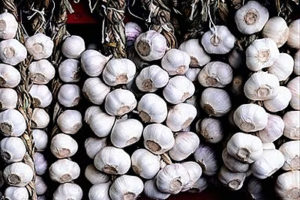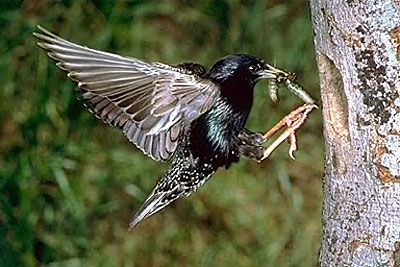 |
| An oil made from garlic can be mixed with a percentage of bird seed and fed to starlings in areas that you want them to avoid. After a taste of the garlic oil-impregnated seed, they’ll do just that. Photograph from Corel Corporation, used with permission. |
by John K. Borchardt
Garlic repels more than just vampires. Scientists have discovered that garlic oil can be a nontoxic, environmentally friendly starling repellent. Neither crops nor birds are harmed by the product, while farmers achieve higher crop yields. In contrast, current bird repellents are toxic and persist in the environment.
Why worry about starlings? From about 60 birds released into New York’s Central Park in the early 1890s, the European starling multiplied and has spread across the United States, becoming a major agricultural pest. Today more than 200 million of these shiny black birds have displaced bluebirds, woodpeckers and other native American birds that nest in cavities. In the summer starlings substantially damage blueberry, cherry, apple and other fruit crops as well as corn in the husk, other garden produce and planted seeds. In the winter, starlings are also pests to livestock, eating out of cattle feed troughs and stealing grain. Individual starlings, which weigh approximately 3 ounces, can eat up to 1 ounce of food per day. Research scientist David Pimentel of Cornell University has estimated that starlings cause $800 million in agricultural damages annually. Localized damage can be intensive, because starlings often feed in large flocks.
However, even when considering only agricultural damages, simply killing starlings is not appropriate. According to the U.S. Department of Agriculture’s Farmers’ Bulletin No. 1571, “The starling is one of the most effective bird enemies of terrestrial insect pests in this country.” Starlings eat large quantities of some of the worst garden and field insect pests. These include Japanese beetles, potato beetles, leaf beetles, wireworms, grasshoppers, cloverleaf weevil and the corn borer. So besides being pests, starlings also save farmers and gardeners millions of dollars.
 |
| Starlings aren’t welcome in gardens or on farms because they pull up seedlings and damage fruit; but they do eat a large number of insects as well. Photograph from Corel Corporation, used with permission. |
So farmers and gardeners shouldn’t kill starlings but should drive them away temporarily while fruits are ripening. Over the years, farmers have tried different methods to shoo European starlings away from their fields, including frightening them with recorded distress calls and covering young crops with special sheeting. Kevin McGowan, an ornithologist at Cornell University, says that starlings have learned to ignore scarecrows.
Current chemical repellents have problems. According to Dr. Eric Block, Distinguished Professor of Chemistry at the University of Albany, “Many current pesticides can be hazardous due to their toxicity and environmental persistence.” For example, Avitrol (active ingredient: 4-aminopyridine) is a Restricted Use Pesticide available in several bait formulations as a pesticide or repellent. Starlings that eat the bait behave erratically and often give warning cries that frighten other birds from the area. However, starlings that eat the bait may also die – a potential hazard to owls and hawks that might eat the dead starling. Avitrol persists in the environment and can remain in soil for up to three years.
In contrast, garlic oil is nontoxic and biodegradable. Block’s team and coworkers at the Monell Chemical Senses Center in Philadelphia found that starlings significantly reduce their food consumption after eating granules containing as little as 1% garlic oil mixed with their food. Their findings were published in the Journal of Agricultural and Food Chemistry.
When fed pellets treated with higher levels of commercial garlic oil (10% and 25% garlic solutions), starlings decreased their food consumption even more. One day after eating food granules containing 25% garlic oil, they decreased their food consumption by almost two-thirds. When the granules contained 10% garlic oil, the next day starlings ate half as much. With only 1% garlic oil in the food granules, next-day food consumption was 17% less.
The product doesn’t work just once. When the same starlings are later fed more food granules containing garlic oil, they again reduce their food consumption. In the wild, the appetite suppressing effects of garlic oil will lead starlings to seek garlic-free areas in which to feed.
According to Professor Block, these results indicate that garlic-based repellents can be “inexpensive, environmentally benign, non-lethal bird repellents” that could be applied to targeted areas as easily as fertilizer. “By coming up with alternatives to pesticides, it gives farmers a fighting chance for his crop to survive and grow,” Block says. He notes that additional tests are needed to determine whether garlic oil will reduce the appetite of other fruit-loving birds, such as blackbirds.
Potential uses include protecting fruit groves, vineyards, home gardens and cattle feed lots. Block also notes, “The products could also be used to keep birds away from airport runways, where they pose an aviation hazard.” Starlings have caused some of the most damaging and fatal bird strikes against airplanes and account for about half of all bird strikes in which the bird species was identified.
Garlic is already widely used in organic gardening because its strong odor naturally repels some insect pests. It thrives in partly sunny to sunny locations when planted in almost any slightly rich soil. It takes little space in small gardens. In dry weather it does need to be watered regularly. The plant forms a bulb comprised of several segments called cloves. The separated cloves should be planted in the fall for a spring crop. Garlic is harvested in midsummer in Maine.
Garlic oil is prepared by soaking raw garlic slices in alcohol containing 15% to 20% water in a closed container for about 20 months at room temperature. The resulting liquid is then filtered and concentrated at a low temperature. Garlic oil products are already available that mix with water and are sprayed on farm and garden plants to keep insects off. The Organic Materials Research Institute lists garlic oil products as suitable for organic farm use. The nonprofit OMRI reviews products for use in organic food production, processing and handling according to standards established with implementation of the USDA National Organic Program (NOP) in October 2002.
To make your own garlic oil-treated seed, allow the oil to impregnate bird seed. Because starlings eat so many different kinds of seeds, almost any birdseed will work. Then 10 to 50% of the treated seed should be mixed with untreated birdseed.
Alliumphobia, the fear of garlic, is a recognized medical condition. Fortunately for organic farmers, while rare in people, alliumphobia appears universal among starlings.
